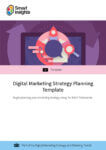E-commerce conversion rate and lead generation landing page stats for desktop and mobile devices for benchmarking averages across different industries
As you will know, conversion rates are often used as a KPI to review the effectiveness of e-commerce sites. Naturally, all site managers and owners want to know the benchmarks - "how do our conversion rates compare?". As consumer and business confidence falls, it's more important than ever to audit and optimize your marketing success metrics.
In this post, I have compiled different free industry sources focusing on retail e-commerce conversion. At the end of this article, we also feature an analysis of landing page lead generation conversion rates by industry sector towards the end of the post. We keep this compilation updated as new conversion data is published in 2023.
E-commerce conversion funnel
This funnel-based view of the conversion process is a useful starting point since as well as the typical average basket and sales conversion rates, it also shows the conversion rates to product page views which aren't published so often:
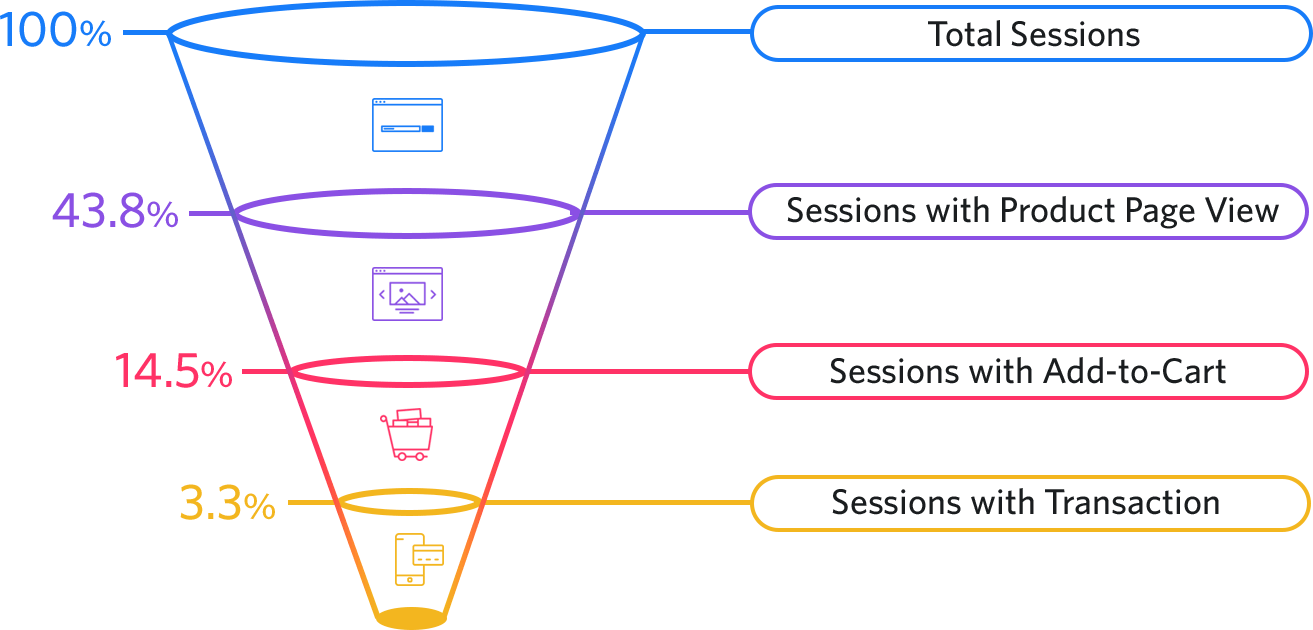
As would be expected, the number of sessions with product page views is much higher than the other micro-conversions, approaching 50 percent. This provides a useful benchmark and prompts retailers that it's useful to assess conversion to product page views when making site design improvements.
Note: This visual was originally created by Sales IQ several years ago, but we have retained it since it gives a clear visualisation of the challenges of conversion rate optimization. Read on to find out the latest conversion rates for B2C E-commerce and conversion rates in different sectors.
Retail conversion rates by region
If your marketing strategy includes geo-targeting, can be particularly useful to come up with country-specific KPIs for segments of your customer base. The key here is for these stats to inform your goals not to define them.
The Kibo e-commerce Quarterly is a great source giving regularly updated benchmarks on conversion in the US, GB, and EMEA, segmented by devices and media for large e-commerce brands.
The latest data was published by Kibo is from Q2 2022. There has been a decline in conversion rates by device which is more pronounced on desktop and tablet.
You can see that desktop and mobile conversion rates are now more similar than previously.
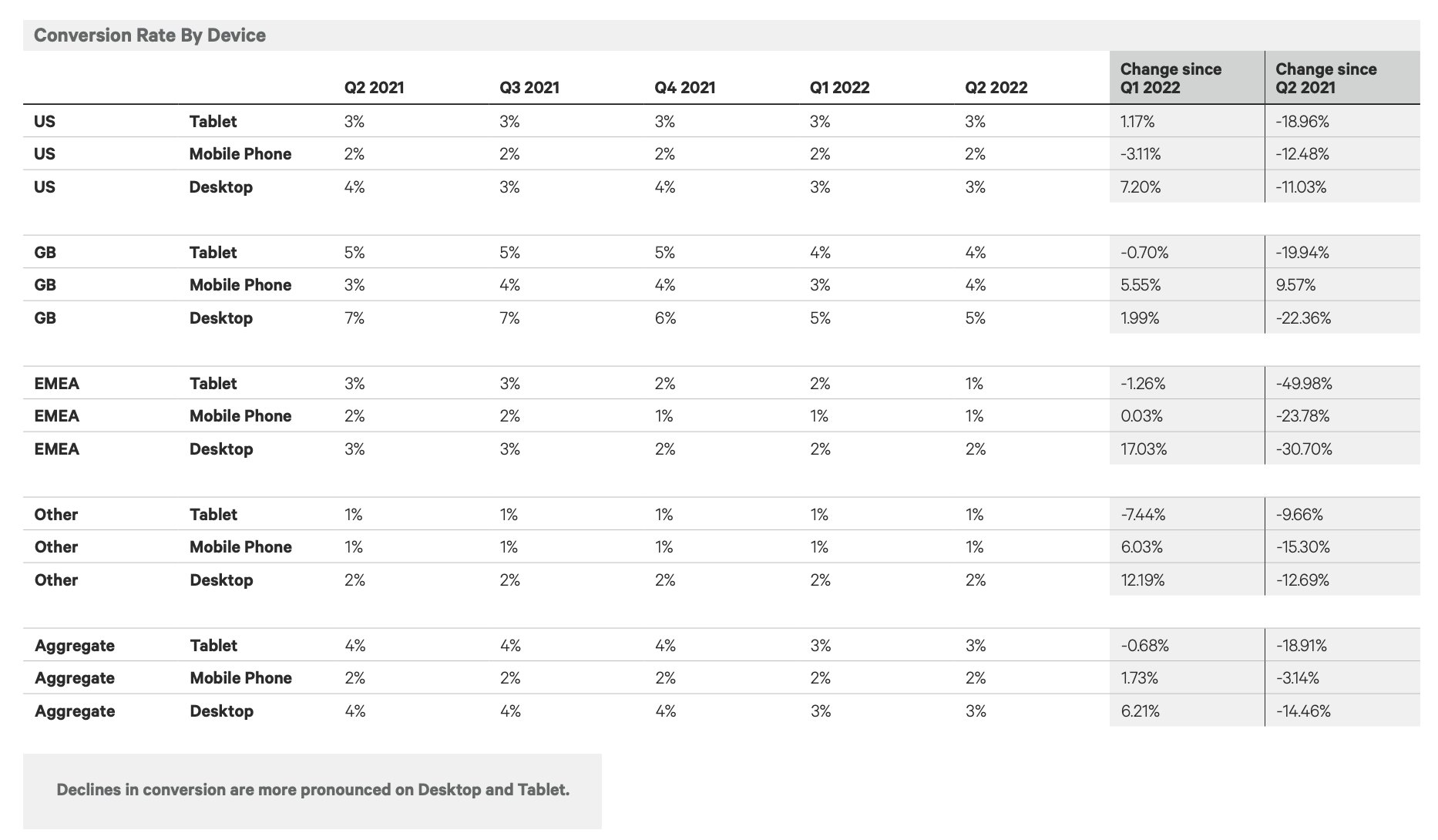
Conversion rate by source shows that the high intent channels, search and email marketing tend to have a higher conversion rate than less directed visitors such as those from social media.
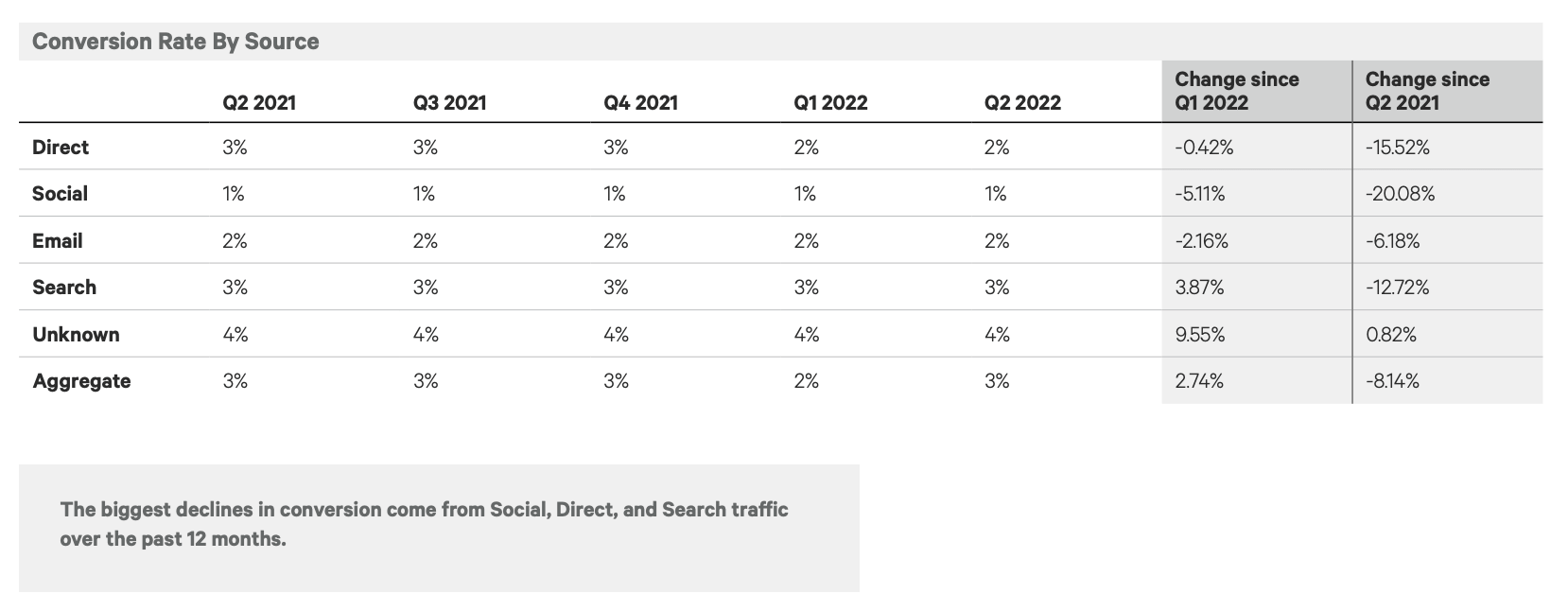
It's also useful to include cart and abandoned cart rates here to get a fuller picture of the funnel. These rates are relatively stable.
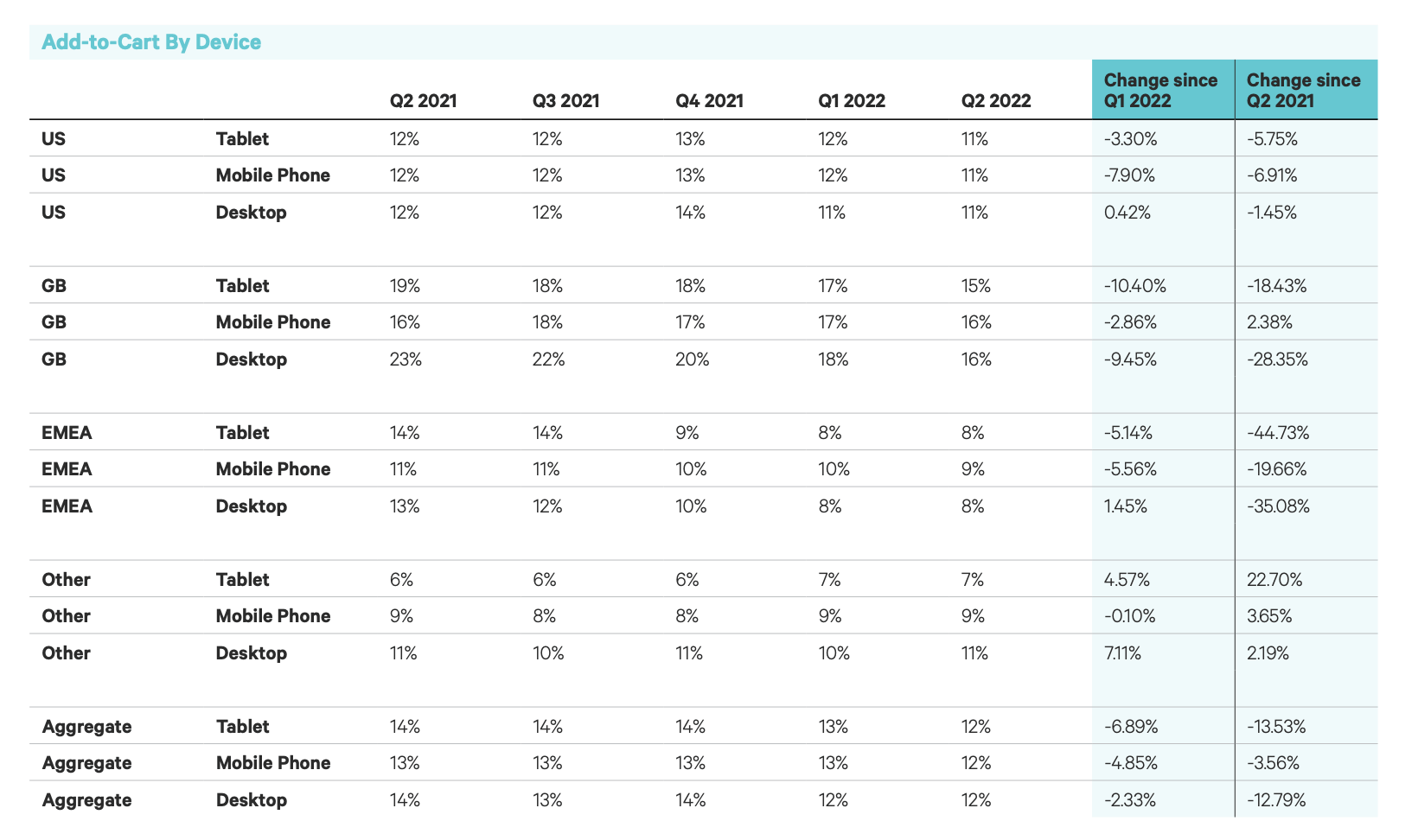
Add-to-cart is typically at 12%. Significantly higher than conversion rates

Abandoned cart rates average 80% across channels.
Digital marketing plan structured to increase e-commerce conversions
Structure your marketing plan around a funnel proven to boost performance. Join Smart Insights as a Free Member for instant access to our free digital marketing plan template to hone your skills and drive the results you need.
Free digital marketing plan template
Our popular marketing planning template is structured across the Smart Insights RACE Framework. Join Smart Insights as a Free Member to download our digital marketing plan template today
Access the Free digital marketing plan template
Seasonal E-commerce data for businesses
This isn't usually available as a benchmark, but it is published for smaller E-commerce businesses using the IRP e-commerce platforms (mainly based in Ireland and the UK). This shows the extent to which both conversion rates and sales levels increase in November and December due to Black Friday and Christmas sales. Since it launched, £2 billion in sales have been recorded by the platform. Data is also available for different sectors. Since the platform also manages visitor acquisition, cost per acquisition and revenue per visit benchmarks are also published.


Lead generation and landing page rates conversion benchmarks by industry
Many marketers set their KPIs based on industry benchmarks. For example, if you’re catering to a market with a lower overall conversion rate, a good conversion rate may still be lower than the average across all industries.
Unbounce's Conversion Benchmark Report compared B2B and B2C landing page conversion rates across 16 industries - with 'catering & restaurants coming up top with an average conversion rate of 9.8%. Agencies and real estate represent the other end of the scale, converting only 2.4% and 2.6% respectively.

Note that this benchmark was published in 2021 and hasn't been updated when we last updated this page.
Landing page form completion conversion rate comparison
Another source to use for both B2C and B2B benchmarking lead generation efficiency which has unique insight breaking down the process by sector is provided by the Zuko form performance benchmarks (last updated 2022).
Form types include purchase, inquiry, and registration data. Most forms tracked are transactional forms of various kinds, but you can see the full breakdown below.

This shows that typically only one-third of people start entering data into the form, showing the value in AB testing to ensure you make the value of completing the form via the title, copy, imagery and follow-up clear. Overall, just under half typically complete each form.
Want to find out more? Keep up to date with the latest e-commerce stats and trends to reach and convert more customers on your digital platforms. We have tools and training to support a data-driven approach to improve your e-commerce conversion rates. Start now.
Omnichannel conversion rates
Compilations of published conversion rates often only consider online conversion to sale. Research by Google and Wolfgang Digital shines a light on ‘research-online purchase-in-store’.
"By uploading Point Of Sale information to Google, retailers can now match in-store purchasers with online ad clickers, gaining further visibility on the success of their campaigns."
The results speak for themselves: digital marketers saw an extra 168% in revenue in their in-store sales, on top of what was made online.

What are the reasons consumers are less likely to buy on smartphones?
The comScore Mobile Hierarchy report has some useful insight into this, which retailers can use to improve their service or messaging to reassure consumers.
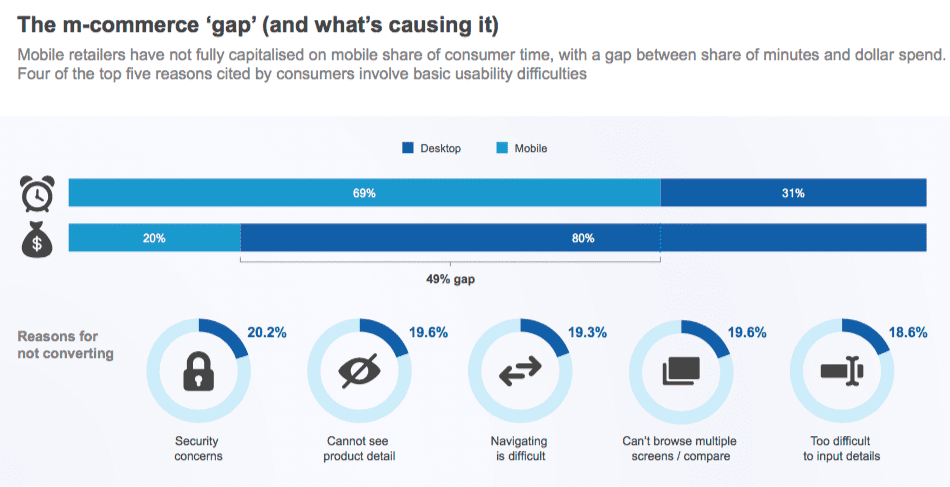
Use our digital marketing plan template to streamline and prioritize your marketing activities across a simple marketing funnel of reach, act, convert, and engage. Find out more.
Free digital marketing plan template
Our popular marketing planning template is structured across the Smart Insights RACE Framework. Join Smart Insights as a Free Member to download our digital marketing plan template today
Access the Free digital marketing plan template
How are e-commerce conversion rates measured?
When benchmarking conversion, it's important to consider the denominator. Are you dividing the number of sales by the number of unique visitors or visitor sessions?
In Google Analytics, which can be considered the standard reference, sales transactions are divided by visits. E-commerce Conversion Rate is defined by Google as:
"The ratio of transactions to sessions, expressed as a percentage. For example, a ratio of one transaction to every ten sessions would be expressed as an Ecommerce Conversion Rate of 10%".
Before we get to the stats, a couple of caveats on benchmarking conversion rates:
When benchmarking conversion rate, we think it's important to explain to marketing managers that they should go beyond headline conversion rates to segment conversion by different types of visitor.
To see why, take a look at Dan Barker's excellent post explaining why conversion rate is a horrible measure to focus on...
Options for segmenting e-commerce conversion rates
As Dan Barker suggests in his advice we mentioned at the start of this post, conversion rate gets more useful as you break it down by different types of visitors with different intent and a different relationship with the retailer.
Different conversion rates and average order values can then be segmented for different audiences to understand and work to improve the quality of traffic or strength of propositions, for example:
- First time, repeat visitor or registered customer conversion
- Referring channel conversion, e.g. paid or natural search, social media, affiliates, display advertising
- Search type, e.g. paid or natural, brand, generic or long-tail
- Product category type - conversion rates are much higher for simple commodity products for example - flower purchase (double-digit percentage) compared with a higher cost product that will often be purchased in-store (for example beds or furniture which will often be less than one percent).
- Promotion type or seasonal sale - the IMRG data and Coremetrics data below shows that conversion rates can increase dramatically at these times.
Keep up to date with the latest digital marketing stats and trends to reach and convert more customers on your e-commerce website. Identify new opportunities to develop your digital strategy and win more customers with our dedicated guidance and support for retailers.













